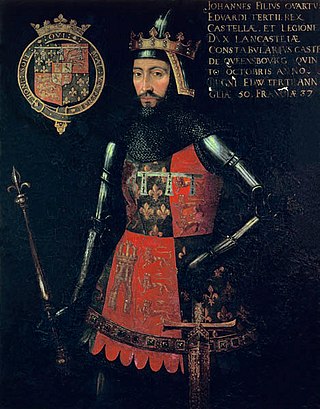Related Research Articles
The High Sheriff of Buckinghamshire, in common with other counties, was originally the King's representative on taxation upholding the law in Saxon times. The word Sheriff evolved from 'shire-reeve'.

This is a list of Sheriffs of Cheshire.
Sheriffs and high sheriffs of Cornwall: a chronological list:
This is a list of the High Sheriffs of Northamptonshire.

The Sheriff is the oldest secular office under the Crown. Formerly the Sheriff was the principal law enforcement officer in the county but over the centuries most of the responsibilities associated with the post have been transferred elsewhere or are now defunct, so that its functions are now largely ceremonial.
This is a list of sheriffs and high sheriffs of the English county of Rutland.
This is a list of Sheriffs and High Sheriffs of Gloucestershire, who should not be confused with the Sheriffs of the City of Gloucester.
This is a list of High Sheriffs of Lincolnshire.
The High Sheriff of Essex was an ancient sheriff title originating in the time of the Angles, not long after the invasion of the Kingdom of England, which was in existence for around a thousand years. On 1 April 1974, under the provisions of the Local Government Act 1972, the title of Sheriff of Essex was retitled High Sheriff of Essex. The high shrievalties are the oldest secular titles under the Crown in England and Wales, their purpose being to represent the monarch at a local level, historically in the shires.
The list of known High Sheriffs of Surrey extends back to 1066. At various times the High Sheriff of Surrey was also High Sheriff of Sussex.

This is a list of the Sheriffs and High Sheriffs of Wiltshire.
This is a list of sheriffs and since 1974 high sheriffs of Cambridgeshire.
The High Sheriff of Hertfordshire was an ancient Sheriff title originating in the time of the Angles, not long after the foundation of the Kingdom of England, which was in existence for around a thousand years. On 1 April 1974, under the provisions of the Local Government Act 1972, the title of Sheriff of Hertfordshire was retitled High Sheriff of Hertfordshire. The High Shrievalties are the oldest secular titles under the Crown in England and Wales, their purpose being to represent the monarch at a local level, historically in the shires.
This is a list of sheriffs and high sheriffs of the English county of Warwickshire.
This is a list of the High Sheriffs of County Durham, England.

The High Sheriff of Lancashire is an ancient officer, now largely ceremonial, granted to Lancashire, a county in North West England. High Shrievalties are the oldest secular titles under the Crown, in England and Wales. The High Sheriff of Lancashire is the representative of the monarch in the county, and is the "Keeper of The King's Peace" in the county, executing judgements of the High Court through an Under Sheriff.
This is a list of the sheriffs and high sheriffs of Staffordshire.
The High Sheriff of West Yorkshire is a current High Sheriff title which has existed since 1974, the holder is changed annually every March. For around 1,000 years the entire area of Yorkshire was covered by a single Sheriff of Yorkshire. After the Local Government Act 1972 the office of Sheriff was changed to High Sheriff and was split to cover several newly created counties, including West Yorkshire.
The High Sheriff of South Yorkshire is a current High Sheriff title which has existed since 1974. The holder is changed annually every March.
The Sheriff of County Dublin was the Sovereign's judicial representative in County Dublin. Initially, an office for a lifetime, assigned by the Sovereign, the Sheriff became an annual appointment following the Provisions of Oxford in 1258. The first recorded Sheriff was Ralph Eure, appointed in that year. The next recorded Sheriff was Sir David de Offington, who was Sheriff in 1282. Besides his judicial importance, the sheriff had ceremonial and administrative functions and executed High Court Writs.
References
- 1 2 Omerod, W. M. (2000). The Lord Lieutenants & High Sheriffs of Yorkshire 1066–2000. Department of History of the University of York. ISBN 1-871647-74-6.
- ↑ "The Rotunda Museum: Trustees". rotundamuseum.org.uk. Retrieved 20 April 2018.
- ↑ "The High Sheriffs' Association". www.highsheriffs.com. Retrieved 20 April 2018.
- ↑ "No. 58639". The London Gazette. 13 March 2008. pp. 3947–3948.
- ↑ "No. 59011". The London Gazette. 19 March 2009. p. 4924.
- ↑ "No. 59364". The London Gazette . 18 March 2010. p. 4707.
- ↑ "No. 59729". The London Gazette . 17 March 2011. p. 4995.
- ↑ "No. 60087". The London Gazette . 15 March 2012. p. 5223.
- ↑ "No. 60447". The London Gazette . 14 March 2013. p. 5102.
- ↑ "No. 60799". The London Gazette . 6 March 2014. p. 4636.
- ↑ "No. 61177". The London Gazette . 23 March 2015. p. 5242.
- ↑ "No. 61527". The London Gazette . 16 March 2016. p. 5942.
- ↑ "No. 61868". The London Gazette . 10 March 2017. p. 5262.
- ↑ "No. 62229". The London Gazette. 15 March 2018. p. 4814.
- ↑ "No. 62586". The London Gazette . 14 March 2019. p. 4643.
- ↑ "No. 62943". The London Gazette . 13 March 2020. p. 5162.
- ↑ "No. 63290". The London Gazette . 11 March 2021. p. 4778.
- ↑ "No. 63644". The London Gazette . 17 March 2022. p. 5082.
- ↑ "No. 63990". The London Gazette . 10 March 2023. p. 4634.